Essential Feeding Habits for Pet Birds
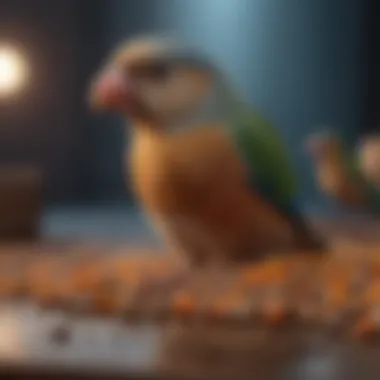
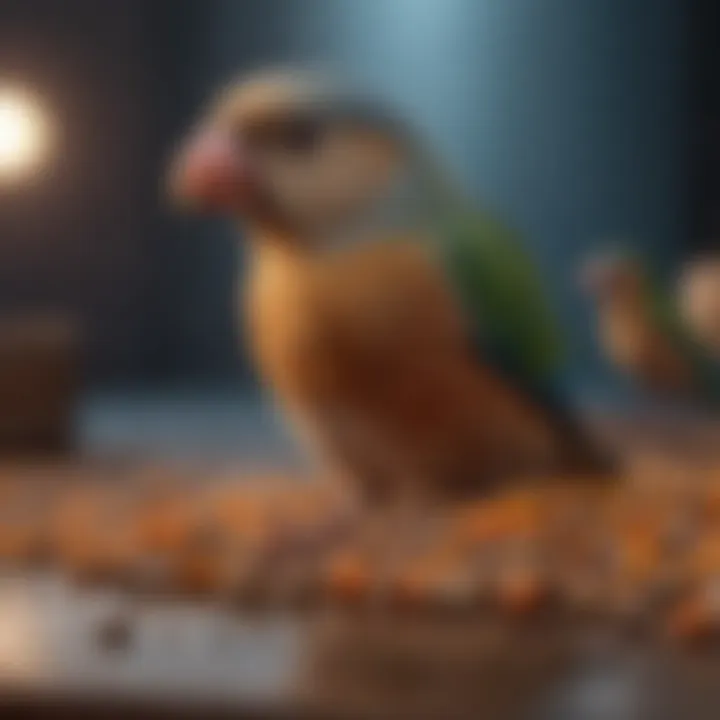
Intro
Caring for pet birds brings much joy, but it also requires understanding their unique dietary needs. Birds are not small mammals; their feeding habits can be quite different from what one might expect. Each species has its own preferences, nutritional requirements, and feeding behaviors, which can impact their overall health and happiness. This guide not only aims to inform bird owners about the nutritional aspects of their feathered companions but also to enrich the bond between bird and caregiver.
As we progress, we’ll explore practical care tips, delve into behavioral insights, and present comprehensive nutrition guides. From understanding daily routines to identifying safe foods and possible toxins, this article is structured to become a valuable resource for pet bird owners, whether you’re a novice or a seasoned bird aficionado. The well-being of your pet bird often hinges on how closely you align their diet with their needs.
Let’s begin with essential care tips.
Feeding Frequency: An Overview
Feeding frequency stands as a cornerstone in maintaining the health and vitality of pet birds. Providing the right amount of food at appropriate times ensures that birds receive the nutrients they need to thrive. Imbalances in feeding routines can lead to various health issues, emphasizing the importance of adopting a structured approach to feeding.
In this piece, we'll unpack the significance of regular feeding, investigate factors that influence how often pet birds should be fed, and delve into the specifics that are crucial for pet bird owners. Understanding these nuances aids in crafting feeding habits that not only meet the nutritional requirements of various species but also encourage positive behaviors.
The Importance of Regular Feeding
Regular feeding establishes a routine that can significantly reduce stress for birds. Just like humans often have specific meal times, birds also benefit from a set schedule. This predictability can aid in digestion and encourage natural foraging behaviors, a key aspect of avian health. A structured feeding regime also enables owners to monitor appetite trends, allowing for early detection of potential health issues.
Birds possess remarkable abilities to adapt to their environments, but consistent feeding times help maintain their physical and emotional well-being. Without regular meals, birds can become anxious or agitated, leading to destructive behaviors.
Moreover, a cycle of consistent feeding contributes to a balanced diet. It prevents owners from overdoing treats or unhealthy snacks, promoting a nutritious approach that aligns with their pet's specific dietary needs.
Factors Influencing Feeding Frequency
While regularity is essential, several factors dictate how often birds should be fed. The intricacies of these variables highlight the need for owners to tailor their feeding routine to each individual pet.
Species Variability
Species variability is a key aspect that governs feeding frequency among pet birds. Different bird species have unique metabolic rates and dietary needs, making it critical to recognize their individual requirements.
For instance, smaller birds like canaries or finches tend to have quicker metabolisms, necessitating more frequent meals throughout the day — sometimes three to four times. In contrast, larger birds such as parrots may thrive on twice-daily feedings. Thus, understanding the species variance plays a role in developing a sustainable feeding routine.
Age and Development
Age and development are influential factors that define feeding frequency. Nestlings and juveniles demand several feedings each day as they grow, requiring owners to be particularly attentive during this phase. As birds transition into adulthood, they often require fewer meals per day, reflecting a shift in nutritional needs and metabolic efficiency.
The transition through life stages calls for adaptability in feeding routines. Parents of young birds need to provide ample nutrition to foster healthy growth while gradually adjusting as their feathered friends mature.
Activity Level
The activity level of the bird is another determinant to consider. Birds that are more active or engaged in play will require additional calories to maintain their energy levels. For instance, playful cockatiels may need more feedings than a less active parrot lounging in its cage.
Monitoring the bird's activity can provide valuable insights. Owners should observe patterns and adjust feeding frequency based on how much their pet moves throughout the day. By aligning feeding habits with activity levels, bird owners can promote health and maintain optimal weight for their companions.
Understanding these three core factors — species variability, age and development, and activity level — equips bird owners with useful insights. By tailoring feeding routines according to these considerations, caretakers can better serve their avian companions, enhancing both nutritional intake and overall well-being.
Species-Specific Feeding Patterns
Understanding the dietary habits of pet birds is not just about throwing some seeds in a bowl and calling it a day. Each species comes with its own unique quirks when it comes to feeding. This specificity matters deeply, as it directly influences their health and wellness. By delving into the species-specific feeding patterns, bird owners can offer tailored diets that cater to the nutritional needs and natural instincts of their feathered companions. This ultimately enhances their well-being and promotes longevity.
Common Pet Bird Species
When we talk about pet birds, a few common species often steal the spotlight. You might find yourself familiar with Parakeets, Cockatiels, and Lovebirds. Each of these fills a different niche with their own behavioral traits and dietary preferences.
- Parakeets: Known for their chatty nature and vibrant colors, they primarily thrive on a varied diet rich in grains and seeds.
- Cockatiels: These affectionate birds have a delicate palate and respond well to fruits and vegetables along with quality pellets.
- Lovebirds: They are small but mighty, often requiring a balanced mix of seeds, vegetables, and sometimes cooked grains.
Recognizing these differences is vital for meeting the needs of each species.
Dietary Needs of Parakeets
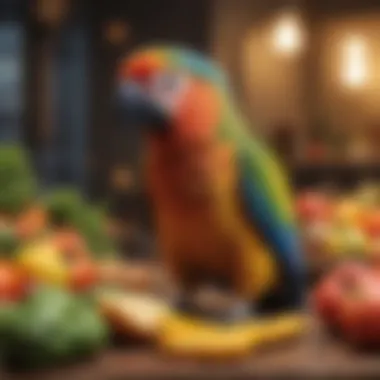
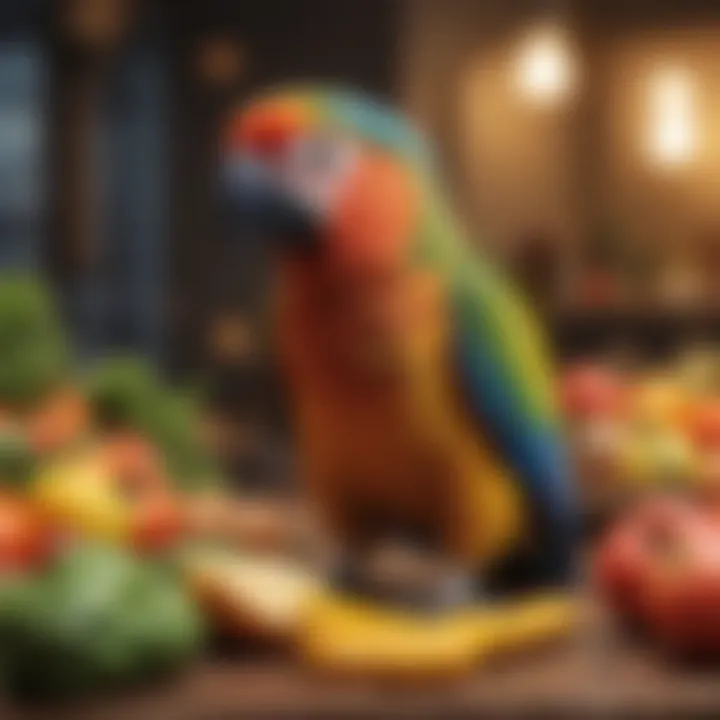
Parakeets require a diet that mirrors their natural foraging behavior. They are omnivores, meaning they need a little of everything—grains, seeds, and fresh vegetables. Here are some key elements:
- Base Diet: A premium quality seed mix designed for budgies can serve as a foundation.
- Fruits and Veggies: Adding fresh produce like carrots, broccoli, and leafy greens can provide essential vitamins.
- Occasional Treats: Small amounts of minerals or even cooked grains can enhance their diet.
By fostering their natural feeding behaviors, you’ll help your Parakeets thrive.
Feeding Requirements for Cockatiels
Cockatiels are a tad more finicky when it comes to their meals, showcasing distinct preferences. They generally fare well with:
- Pellets: A formulated pellet designed for cockatiels will provide balanced nutrition.
- Fresh Offerings: Fruits like apples (without seeds) and vegetables such as spinach should make regular appearances in their diet.
- Seeds: While seeds shouldn't dominate, a modest inclusion can serve as an enticing treat.
Notably, Cockatiels are known for their social feeding habits. They often enjoy sharing meals, which can also be a bonding experience for their human caretakers.
Nutritional Guidelines for Lovebirds
Lovebirds are small bundles of energy, and their nutritional needs reflect that vibrancy. An optimal diet for Lovebirds typically includes:
- Quality Seeds: A mix specifically formulated for Lovebirds is essential; avoid mixes heavily based on sunflower seeds to prevent obesity.
- Fresh Foods: Introduce a variety of chopped fruits and veggies—think bell peppers, melons, or leafy greens.
- Supplemental Grains: Occasional servings of cooked quinoa or whole grains can spice things up and provide necessary fiber.
These birds thrive on freshness and variety, so keeping their diet colorful is as important as keeping it nutritious.
"A balanced diet is vital for maintaining a vibrant and healthy pet bird".
Species-specific feeding patterns play a huge role in pet bird health. Knowing what each bird species needs and what they enjoy can lead to happier, healthier companions.
Types of Food: Balanced Nutrition
When it comes to feeding pet birds, a well-rounded diet can make all the difference. Just as humans need a balance of nutrients, birds, too, thrive with a diverse range of food. Understanding the different types of foods ensures that feathered friends not only survive but thrive, following their natural dietary patterns. In this section, we will dive into the variations among seeds, pellets, fresh produce, and supplementary options, detailing their importance for pet bird health.
Seeds vs. Pellets
The debate between seeds and pellets has been ongoing in avian care. Seeds, while a beloved staple for many birds, can be high in fat and low in essential nutrients. They often lack the balance of vitamins needed for overall health. On the other hand, pellets are designed to provide a complete nutrition profile. They combine various essential ingredients into one compact form, making it easier for bird owners to ensure their pets get what they need.
Both seeds and pellets have pros and cons:
- Seeds:
- Pellets:
- Pros: Generally more palatable and can keep birds engaged during eating. They can be used as treats or rewards during training.
- Cons: Risk of obesity and missing vital nutrients.
- Pros: Offer complete nutrition in a single source, promoting overall health and reducing the chances of dietary-related health issues.
- Cons: Some birds may resist or dislike pellets initially, requiring a transition period.
Transitioning from a seed-based diet to pellets may take time, but with patience and creativity, owners can encourage their feathered companions to embrace this nutritionally sound option.
Fresh Fruits and Vegetables
Adding fresh fruits and vegetables to a pet bird's diet presents an excellent avenue for enhancing nutrition. These foods are often rich in vitamins, minerals, and antioxidants that are vital for a bird's overall health.
Birds can benefit from a variety of options, such as:
- Leafy Greens: Kale or spinach can be great sources of calcium and vitamins.
- Berries: Blueberries and strawberries provide antioxidants and are often very appealing to birds.
- Root Vegetables: Carrots can contribute to both health and enjoyment, offering crunch and sweetness.
One should introduce fresh produce gradually, as some birds may not be accustomed to the textures and tastes of fruits and vegetables. It's crucial to ensure that any produce provided is thoroughly washed and pesticide-free, preparing it in manageable bites to facilitate easy consumption.
Supplementary Foods
While a main diet of seeds, pellets, and produce is advantageous, supplementary foods can further enhance the diet.
Nuts
Nuts are another beneficial addition to a pet bird's diet. They are rich in healthy fats, proteins, and various vitamins, contributing to overall well-being. Options like almonds, walnuts, and pistachios are good choices, but moderation is key due to their high-fat content.
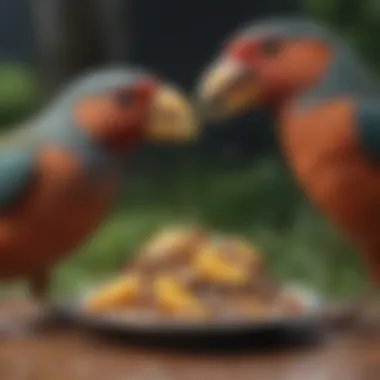
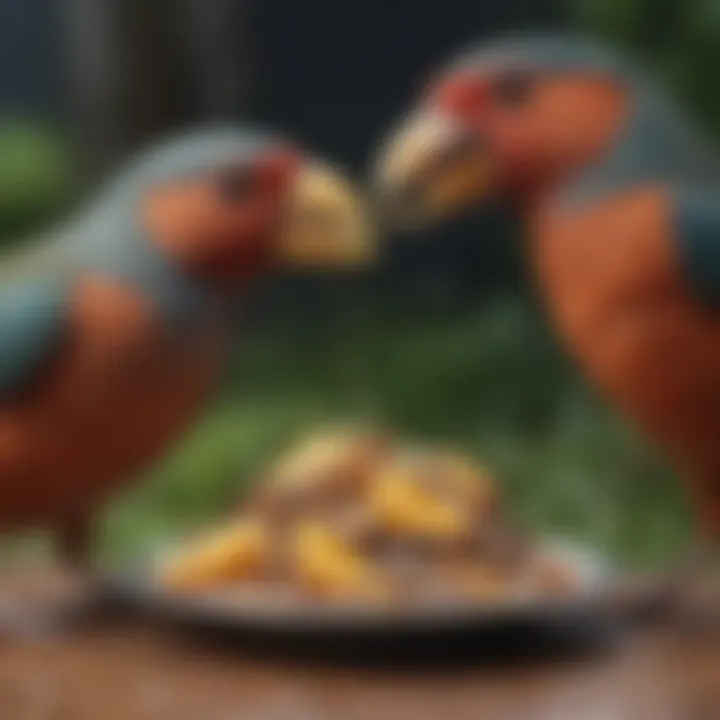
Moreover, nuts serve as excellent enrichment tools to stimulate mental engagement. Birds often use their beaks to crack open shells, satisfying their instinctual behaviors and enhancing their physical health. However, be mindful not to overdo it, as excess fats can lead to issues:
- Key characteristic: High in healthy fats and proteins.
- Advantage: Provide tasty and engaging snacks that aid physical and mental health.
- Disadvantage: Risk of obesity if fed too liberally.
Grains
Grains, like quinoa or brown rice, add variety and complement a bird's diet remarkably well. They can serve as a great source of carbohydrates and energy, necessary for active birds. Grains are also typically liked due to their pleasant textures.
Many birds will readily accept grains, making them a popular yet nutritious option:
- Key characteristic: Source of carbohydrates and fiber.
- Advantage: Rich in energy, providing active birds with fuel for their spirited antics.
- Disadvantage: Should be balanced with other food types to prevent over-reliance.
Incorporating a mix of these food types—seeds, pellets, fresh fruits and vegetables, nuts, and grains—can craft a highly beneficial diet for pet birds. Each category offers unique benefits, and understanding them allows bird owners to make informed decisions for their feathered friends, ensuring health and vitality in each meal.
Observed Eating Behaviors
Understanding how pet birds eat is more than a matter of filling a bowl and calling it a day. Observed eating behaviors are like window into the overall well-being of these feathered companions. By paying attention to how, when, and what your bird eats, you can’t only ensure they receive balanced nutrition but also monitor their health.
Birds, like humans, have their unique quirks when it comes to feeding. Observing these behaviors can help an owner identify preferences, which can guide a canny pet parent in selecting the right foods. It’s not only about nutritional content but also about meeting their instinctual needs. This is crucial; if a bird feels safe and engaged during meal times, they’re more likely to eat well.
Additionally, changes in eating behavior could be a signal something is off. A noticeable drop in appetite or sudden selectivity can imply underlying health issues. Monitoring these behaviors lets you catch potential problems early, allowing for timely intervention.
Understanding Natural Feeding Instincts
Pet birds possess wild ancestors who are accustomed to foraging and exploring varied environments for food. This instinctual behavior is still etched in their actions. In your home, it's vital to replicate this experience in as safe a manner as possible. Here are some ways to encourage natural feeding habits:
- Variety: Offer a range of seeds, pellets, fruits, and veggies. Birds thrive on variety; it keeps their interest piqued and encourages exploration.
- Foraging Opportunities: Hide treats in different food containers or scatter them in their living space. This mimics the foraging they would do in the wild and keeps their minds active.
- Mindful Feeding Techniques: Using small, shallow dishes allows the bird to dig and pick at their food—more akin to how they would eat in the wild.
Shifting the focus on how birds eat rather than just what they eat creates a richer feeding experience. Engaging their curiosity and instincts helps maintain a joyful, healthy relationship with food.
Social Aspects of Feeding
Feeding isn’t just a solitary act for your pet bird; it’s an opportunity for social interaction. Birds are inherently social animals, and how they engage during meal times often reflects their mood and well-being. Observing your pet bird's social behavior during feeding can reveal several key aspects about their personality and health:
- Interaction: Birds often share feeding time with friends—both feathered and human. Watching your bird eat alongside others can indicate comfort and social bonding. Providing multiple feeding stations can facilitate this.
- Competition: Some birds exhibit competitive eating behavior. If you own more than one bird, observe how they interact. If one bird dominates food access, you may need to intervene to ensure balanced nutrition for all.
- Feeding Choreography: The act of eating together can also demonstrate social roles or hierarchies, particularly in larger flocks. Subtle behaviors, such as preening or posturing, can emerge during these moments, providing a deeper understanding of social dynamics.
By understanding the social elements tied to feeding, owners can enrich their pet's life, ensuring that mealtimes become not just about nourishment but also a cherished social event.
Health Implications of Feeding Practices
When it comes to the health of pet birds, feeding practices hold immense significance. A well-balanced diet not only promotes physical health but also influences behavior, energy levels, and even lifespan. Conversely, poor feeding practices can lead to serious health repercussions. Pet owners need to recognize the direct connection between a bird's diet and its well-being, as neglecting this aspect can lead to complications that may sometimes be irreversible.
Overfeeding and Obesity Risks
One prevalent issue faced by many bird owners is overfeeding. Birds seem to have an appetite that knows no bounds, and that can make them vulnerable to weight gain. Overweight birds can suffer from various health problems such as heart disease, liver complications, and joint issues.
It’s important to understand that pet birds often express interest in food simply out of boredom rather than hunger. This leads to a common pitfall where a caring owner fills the bowl without evaluating the bird's actual need for food. To combat this, consider the following:
- Portion Control: Measure food portions based on the bird’s species, age, and activity level.
- Scheduled Feeding: Implement regular feeding times rather than free-feeding so that your bird develops a routine and doesn’t overindulge.
- Healthy Choices: Focus on nutritionally-rich foods, replacing high-fat seeds or snacks with fresh fruits and veggies.
Bird owners should also keep an eye on behavior changes. If a bird becomes lethargic or is less active than usual, it may be a signal of weight-related issues.
"An ounce of prevention is worth a pound of cure.” Taking faced risks seriously now can save a lot of heartache later.
Underfeeding and Nutritional Deficiencies
On the other end of the spectrum lies the risk of underfeeding. Many first-time bird owners might think that a smaller portion will help keep their feathered friends healthy, but this can cause significant issues. Birds require a range of nutrients to maintain their health, and a diet lacking in variety can lead to nutritional deficiencies.
Deficiency can lead to symptoms such as feather problems, weakened immune response, and more severe issues like bone deformities. It's vital to remember to provide a well-rounded diet that includes:
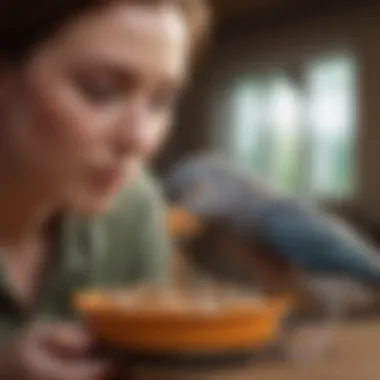

- High-quality Pellets: These should form the bulk of a pet bird's diet. They are specially formulated to meet the nutritional needs of specific species.
- Fresh Fruits and Vegetables: Ensure that these form a regular component of what you offer. They provide essential vitamins and minerals that may be lacking in dried foods.
- Grains and Nuts in Moderation: While these can be good sources of calories and nutrients, they should not make up the majority of the diet.
Birds, like humans, thrive on variety. Thus, offering a diverse menu can help avoid deficiencies that could lead to health problems down the road. It is also worth consulting with an avian veterinarian to tailor an appropriate feeding plan that ensures your bird gets all that it needs to flourish.
Adjusting Feeding Routines
Maintaining a proper feeding routine for pet birds is pivotal in ensuring their health and happiness. Just as you wouldn’t want to eat throughout the day without a schedule, your birds also thrive on regularity in meal times. Thus, adjusting feeding routines becomes not just a necessity but a practice that can positively impact your avian companions. In this section, we will explore how to effectively transition between different types of foods and adapt to new feeding schedules, both of which play a significant role in your birds' overall well-being.
Transitioning Between Foods
Switching your bird’s food can be a bit like changing a recipe. It requires careful consideration and a methodical approach. For many bird owners, the transition between different types of food—like from seeds to pellets or from one brand of pellets to another—can be daunting. The first thing to keep in mind is that a sudden change may upset their digestive system. It's wise to introduce new foods gradually. Mix the new food with their existing diet, slowly increasing the quantity of the new items. This method is not only gentler on their tummies, but it also allows your bird to acclimate to different textures and flavors.
Here’s a simple guideline for transitioning:
- Day 1-3: 70% old food, 30% new food.
- Day 4-6: 50% old food, 50% new food.
- Day 7-10: 30% old food, 70% new food.
- After Day 10: You can aim for a 100% new diet, if your bird seems to enjoy it.
Another element to consider is the bird's natural behavior. For some birds, the novelty of different flavors can be quite exciting, while others may be more hesitant. Birds are naturally inquisitive creatures, so it may help to present new foods during their active hours, typically in the morning or early evening.
Acclimating to New Feeding Schedules
Just like a child who needs a bedtime routine, birds thrive on consistency in mealtimes. This becomes especially important if you find yourself needing to change feeding schedules, perhaps due to a new work commitment or lifestyle adjustment.
To acclimate your pet bird to a new feeding schedule, start by gradually shifting their meal times. If your bird is used to being fed in the morning at 7 AM and you need to push that to 8 AM, try feeding them at 7:30 AM for a few days. Then, inch it up to the desired time. This slow integration helps lessen any stress associated with the change. Remember that birds can be sensitive to sudden shifts, so patience is key.
Consider also their natural instincts; many birds are crepuscular, meaning they are most active around dawn and dusk. Tailoring their feeding times around these periods can enhance their feeding experience. As birds become accustomed to new schedules, monitor their behavior during meal times; they should exhibit enthusiasm when food is presented.
"Small changes can lead to big results in making your bird feel comfortable and secure about their meals."
Monitoring Food Intake
Monitoring food intake in pet birds is crucial for ensuring their overall health and longevity. Parrots and their feathered friends, like any other animal, require attention to their feeding habits. Proper management can prevent a range of health issues, such as obesity, malnutrition, and behavioral problems. Owners should continuously observe how much and what types of food their birds consume.
Establishing Routine Observation
Establishing a routine to observe your bird’s feeding habits is the first step in effective monitoring. This involves taking note of feeding times, portion sizes, and food types served. A consistent schedule helps create a familiar environment for birds, allowing them to thrive.
- Daily Check-ins: Make it a habit to observe your pet bird at mealtime every day. This practice helps identify any changes in behavior or preferences over time.
- Record Keeping: Keeping a food diary can offer valuable insights into your bird's diet. You can jot down what’s been served and how much was eaten. If you notice a decrease in food consumption, it may indicate an underlying health concern.
- Monitor Environment Factors: Consider that external factors like weather changes or disturbances from other pets might affect eating habits. Being aware of these influences allows you to adjust food offerings accordingly.
Identifying Normal Eating Behavior
To effectively monitor your bird's food intake, it's essential to understand what constitutes normal eating behavior. Analyzing typical patterns helps detect anomalies early, which is vital for prompt intervention.
- Visual Cues: Observe your bird while it eats. A healthy bird will exhibit enthusiasm while breaking into its food. Look for signs like foraging or moving food around in the cage.
- Varied Diet: Healthy birds usually enjoy a varied diet. If your bird is shunning certain foods entirely, it might be worth investigating. For example, if your cockatiel stops eating fresh veggies, a different preparation method may entice it.
- Eating Rhythm: Birds are creatures of habit and often have a rhythm to their eating. Some may peck away at food throughout the day, while others might gorge during designated meal times. Disruptions in this pattern could signal health issues.
"Understanding your bird’s eating habits requires patience, observation, and a keen sense of what’s normal. Always be ready to adjust your strategies if you notice something off."
By keeping an eye on feeding habits and being proactive in identifying changes, pet owners can better manage their bird’s nutritional needs, resulting in healthier, happier companions.
Consulting with Avian Experts
In the complex tapestry of pet bird care, consulting with avian experts stands as a critical thread, weaving in essential knowledge and practical wisdom. Birds, unlike other common pets, have unique dietary needs that evolve with their species, age, and health conditions. Engaging with professionals in avian health can illuminate the intricacies of feeding habits, helping owners navigate this crucial aspect of bird care. Not just a casual chat, these consultations can be the difference between a well-nourished bird and one at risk of health issues due to inadequate or inappropriate nutrition.
When to Seek Professional Help
There are several situations where it’s wiser to seek guidance from an avian vet or an experienced bird nutritionist, rather than relying solely on general information. For instance:
- Unexpected Changes in Eating Behavior: If your bird suddenly shies away from its food or displays unusual eating habits, this can signal underlying health issues. Prompt consultation can lead to early detection and treatment.
- Specific Dietary Concerns: Species-specific nutritional requirements can be complex. If unsure about what your bird should eat or how to transition foods, professionals offer insights that books or articles may not cover.
- Changing Life Stages: As birds age, their needs shift. Young birds may require more protein for growth, while older birds benefit from lower-fat diets. Understanding these shifts calls for expert advice.
An avian expert can help address such quandaries. They can offer tailored recommendations based on your bird's unique background and current condition.
Understanding Dietary Recommendations
Understanding what to feed your pet bird goes beyond merely filling up a dish with seeds. It requires an intentional approach grounded in veterinary advice. Key considerations include:
- Species Specificity: Different birds have distinct needs. For instance, while a canary may thrive on a seed mix designed for small finches, a cockatoo may need a varied diet rich in fresh produce and pellets.
- Life Stages: Younger birds, like chicks, may require high protein diets for growth, funded by advice from avian professionals to ensure these feathery companions are well-fed through each life stage.
- Health Conditions: Birds can be susceptible to conditions like obesity or malnutrition if their diets are improperly managed. An expert can recommend adjustments and alternatives to prevent these outcomes.
- Balanced Nutrition: Just as humans require a variety of nutrients, so too do birds. An avian vet can explain how to achieve balance through seeds, pellets, and fresh foods, ensuring all dietary needs are met without deficiencies.
In sum, enlisting the help of avian experts enhances the knowledge base of bird owners. Through their insights, a clearer pathway emerges toward maintaining not only the health of pets but their happiness as well. As you delve deeper into understanding your feathered friends, don’t shy away from professional support it can offer the guidance needed to optimize their feeding habits.















